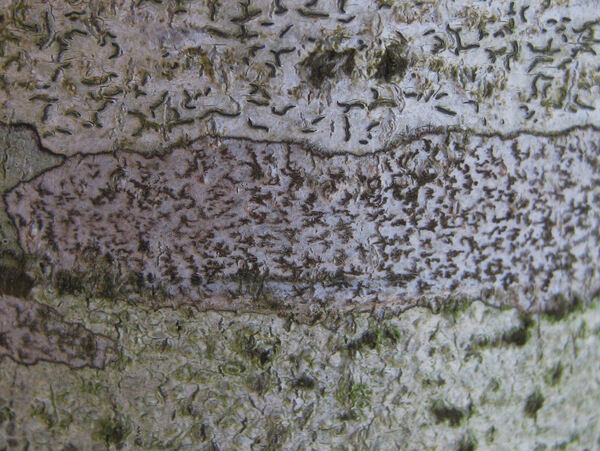Arthonia stellaris Kremp.
Denkschr. kgl. bayer. bot. Ges., 4, 2: 296, 1861.
Synonyms: Arthonia armoricana Leight.
Distribution: C - Tosc (Benesperi & al. 2007), Laz (Stofer 2006).
Description: Thallus crustose, mostly endosubstratic, white to pale grey-white or yellowish white, forming 1-2(-4) cm wide, often confluent patches sometimes delimited by a brown prothalline line. Apothecia arthonioid, emarginate, red-brown to brown-black, epruinose but sometimes covered in a thin layer of bark cells, at first rounded or subangular, but soon becoming linear or irregularly branched to stellate, the aggregates 0.2-1,2(-2) mm wide, the lobes 0.08-0.15 mm wide, in section 60-95 μm tall. Proper exciple poorly developed; epithecium red-brown to pale olive-brown, 10-15 μm high, K+ pale green; hymenium colourless or pale red-brown in upper part, 40-50 μm high, I+ blue; paraphysoids branched and anastomosing in upper part, (0.5-)1(-1.5) μm thick, the apical cells brown-walled and up to c. 2 μm wide; hypothecium colourless to pale red-brown, 5-20 μm high, patchily K+ pale green. Asci 8-spored, subglobose to broadly clavate, semi-fissitunicate, with a large apical dome, and a distinct ocular chamber, Arthonia-type. Ascospores (2-)3(-4)-septate, with an enlarged apical cell, hyaline but turning brown and warted when overmature, obovoid to cylindrical-obovoid, (13-)18-22(-26) x (5-)6-8(-9) μm. Pycnidia rare, immersed, 40-60 μm across, the wall red-brown, K+ pale green. Conidia bacilliform, 4.5-5.5 x 0.5-1 μm. Photobiont trentepohlioid or absent. Spot tests: thallus K-, C-, KC-, P-, UV-. Chemistry, an unidentified lichen substance in thallus. Note: a mild-temperate lichen found on smooth bark, e.g. of Corylus, and in Abies-Fagus forests; mainly Tyrrhenian in Italy. It is included in the Italian red list of epiphytic lichens as “Endangered” (Nascimbene & al. 2013c).
Growth form: Crustose
Substrata: bark
Photobiont: Trentepohlia
Reproductive strategy: mainly sexual
Most common in areas with a humid-warm climate (e.g. most of Tyrrenian Italy)
Commonnes-rarity: (info)
Alpine belt: absent
Subalpine belt: absent
Oromediterranean belt: absent
Montane belt: extremely rare
Submediterranean belt: absent
Padanian area: absent
Humid submediterranean belt: extremely rare
Humid mediterranean belt: absent
Dry mediterranean belt: absent

Predictive model
Herbarium samples
Growth form: Crustose
Substrata: bark
Photobiont: Trentepohlia
Reproductive strategy: mainly sexual
Most common in areas with a humid-warm climate (e.g. most of Tyrrenian Italy)
Commonnes-rarity: (info)
Alpine belt: absent
Subalpine belt: absent
Oromediterranean belt: absent
Montane belt: extremely rare
Submediterranean belt: absent
Padanian area: absent
Humid submediterranean belt: extremely rare
Humid mediterranean belt: absent
Dry mediterranean belt: absent

Predictive model
| Herbarium samples |
 INDEX FUNGORUM
INDEX FUNGORUM
 GBIF
GBIF


